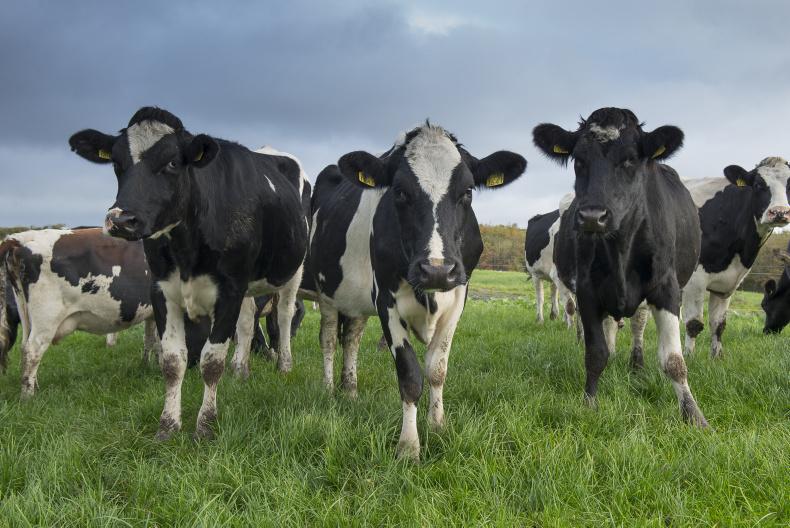Last Tuesday, Teagasc held what was, within the context of what it was aiming to achieve, one of the best economic conferences I was ever at.
There was the normal review of how 2016 had gone – I was surprised that in fact the net result was an income standstill in the sector, despite sharply reduced milk prices, somewhat reduced beef and weanling prices, as well as lower yields and prices on the tillage side.
While sheep and pigs saw an improvement, the main influence in the better-than-expected standstill in incomes was the increase in some direct payments. But as IFA chief economist Rowena Dwyer pointed out, the flattening of the direct payments has a negative effect on the tillage sector.
But the real take-home message for many of those attending was the huge resilience of the Irish dairy farming sector. I was taken aback that the average cost of producing a litre of milk had dropped from 27c in 2013 to 21c in 2016. This was primarily because, with the removal of quotas, the average dairy farm in the country expanded production on the basis of grass utilisation with very little extra costs. This meant that the average fall of 11% in 2016 milk prices translated into a 27% drop in per-litre margin but it has left the sector supremely well set up to take advantage of the improvement already taking place, with the Teagasc team forecasting an increase of 73% in income for 2017 compared with 2016.
The favourable Irish environment for dairying was re-emphasised in a most welcome look at the trends in the international competitiveness of Irish dairying. Within Europe, of the major, main producing countries, we had the lowest cash costs of producing a litre of milk, though the Dutch still beat us when total costs are taken into account.
Given the fact that per utilisable area of land, the Dutch until the removal of quotas, had nine times the quota per acre. We should not be surprised that they have developed a much more intensive use of their land, building and facilities base and so, spread their investment per ha over a much larger volume.
Internationally, we seem to have the most favourable returns relative to costs in the world, though the worth of a farmers own labour and land still have to be quantified but the resilience of the model developed by Moorepark is beyond question.
Read more
Full coverage: Teagasc outlook 2017
Last Tuesday, Teagasc held what was, within the context of what it was aiming to achieve, one of the best economic conferences I was ever at.
There was the normal review of how 2016 had gone – I was surprised that in fact the net result was an income standstill in the sector, despite sharply reduced milk prices, somewhat reduced beef and weanling prices, as well as lower yields and prices on the tillage side.
While sheep and pigs saw an improvement, the main influence in the better-than-expected standstill in incomes was the increase in some direct payments. But as IFA chief economist Rowena Dwyer pointed out, the flattening of the direct payments has a negative effect on the tillage sector.
But the real take-home message for many of those attending was the huge resilience of the Irish dairy farming sector. I was taken aback that the average cost of producing a litre of milk had dropped from 27c in 2013 to 21c in 2016. This was primarily because, with the removal of quotas, the average dairy farm in the country expanded production on the basis of grass utilisation with very little extra costs. This meant that the average fall of 11% in 2016 milk prices translated into a 27% drop in per-litre margin but it has left the sector supremely well set up to take advantage of the improvement already taking place, with the Teagasc team forecasting an increase of 73% in income for 2017 compared with 2016.
The favourable Irish environment for dairying was re-emphasised in a most welcome look at the trends in the international competitiveness of Irish dairying. Within Europe, of the major, main producing countries, we had the lowest cash costs of producing a litre of milk, though the Dutch still beat us when total costs are taken into account.
Given the fact that per utilisable area of land, the Dutch until the removal of quotas, had nine times the quota per acre. We should not be surprised that they have developed a much more intensive use of their land, building and facilities base and so, spread their investment per ha over a much larger volume.
Internationally, we seem to have the most favourable returns relative to costs in the world, though the worth of a farmers own labour and land still have to be quantified but the resilience of the model developed by Moorepark is beyond question.
Read more
Full coverage: Teagasc outlook 2017






 This is a subscriber-only article
This is a subscriber-only article










SHARING OPTIONS: